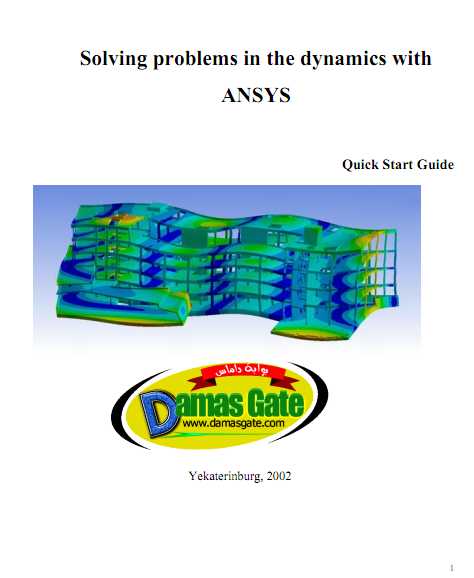Solving Problems in the Dynamics with ANSYS

The contents of this book can be divided into two parts. The first part contains instructions for harmonic analysis, dynamic analysis of transients, spectral analysis. It details the features of these programs, the possible options of their application, are some examples. For example, in the chapters on harmonic analysis and the analysis of transients considered three possible methods: full, truncated (reduced) using the main degrees of freedom, and the method of superposition of modes. The advantages and disadvantages of each of these methods.
The second part is devoted to some theoretical illustrations issues discussed in the first part. For example, the theoretical basis of the method of superposition of modes (in Russian literature it is called the method of expansion in their own forms). Briefly reviewed random fluctuations. Briefly reviewed univariate and multivariate analysis, as well as issues of cross-correlation spectral densities. Of course, this review is in no way claim to be complete and only serves as the first part.
1.1. Introduction
Cyclic load will result in a harmonic response of mechanical systems. Harmonic analysis is used to find the steady response of linear systems loaded with
sinusoidal forces. The calculation is performed by finding the system response at several frequencies and plot the frequency response. Maximum response found on the schedule and will meet the maximum stresses in the structure. Harmonic analysis is used for finding the maximum levels steady vibration. Transients are not evaluated in this kind of analysis.
Harmonic analysis is a linear analysis. Some non-linearity, such as plasticity, contact phenomena, or gaps will be ignored, even if they are defined in the system. The harmonic analysis can be applied to prestressed designs, such as a violin string (assuming that the voltage of the harmonic load substantially less than that of the prestressing).
There are three methods of analysis: full, truncated and the method of superposition of modes. (Fourth, relatively "expensive" - a method of transient analysis for a harmonic load, represented as a function of time). Program ANSYS / Linear Plus allows only the method of superposition of modes. Before learning how to use these methods, consider the advantages and disadvantages of each method.
1.2 Complete Method The complete method is the simplest of the three methods. It uses the full
system matrices to calculate the harmonic amplitudes of vibration. Matrices may be symmetric or symmetric. Full advantage of the method are:
Easier to use because you do not have to worry about choosing the main degrees of freedom, or their own forms;
It uses the full matrix, so that the approximation of the mass matrix is not needed;
It allows you to use non symmetric matrices that are typical for some applications, particularly for acoustic problems;
It calculates the displacements and stresses; It supports all types of loads: forces at the nodes specified (non-zero)
displacement, load elements (temperature and pressure). He makes good use of solid-state load.
The disadvantage is that it does not allow for pre-loading. Another disadvantage of this method is that it is relatively "expensive" compared with the other two methods.
The second part is devoted to some theoretical illustrations issues discussed in the first part. For example, the theoretical basis of the method of superposition of modes (in Russian literature it is called the method of expansion in their own forms). Briefly reviewed random fluctuations. Briefly reviewed univariate and multivariate analysis, as well as issues of cross-correlation spectral densities. Of course, this review is in no way claim to be complete and only serves as the first part.
1.1. Introduction
Cyclic load will result in a harmonic response of mechanical systems. Harmonic analysis is used to find the steady response of linear systems loaded with
sinusoidal forces. The calculation is performed by finding the system response at several frequencies and plot the frequency response. Maximum response found on the schedule and will meet the maximum stresses in the structure. Harmonic analysis is used for finding the maximum levels steady vibration. Transients are not evaluated in this kind of analysis.
Harmonic analysis is a linear analysis. Some non-linearity, such as plasticity, contact phenomena, or gaps will be ignored, even if they are defined in the system. The harmonic analysis can be applied to prestressed designs, such as a violin string (assuming that the voltage of the harmonic load substantially less than that of the prestressing).
There are three methods of analysis: full, truncated and the method of superposition of modes. (Fourth, relatively "expensive" - a method of transient analysis for a harmonic load, represented as a function of time). Program ANSYS / Linear Plus allows only the method of superposition of modes. Before learning how to use these methods, consider the advantages and disadvantages of each method.
1.2 Complete Method The complete method is the simplest of the three methods. It uses the full
system matrices to calculate the harmonic amplitudes of vibration. Matrices may be symmetric or symmetric. Full advantage of the method are:
Easier to use because you do not have to worry about choosing the main degrees of freedom, or their own forms;
It uses the full matrix, so that the approximation of the mass matrix is not needed;
It allows you to use non symmetric matrices that are typical for some applications, particularly for acoustic problems;
It calculates the displacements and stresses; It supports all types of loads: forces at the nodes specified (non-zero)
displacement, load elements (temperature and pressure). He makes good use of solid-state load.
The disadvantage is that it does not allow for pre-loading. Another disadvantage of this method is that it is relatively "expensive" compared with the other two methods.
Download
*